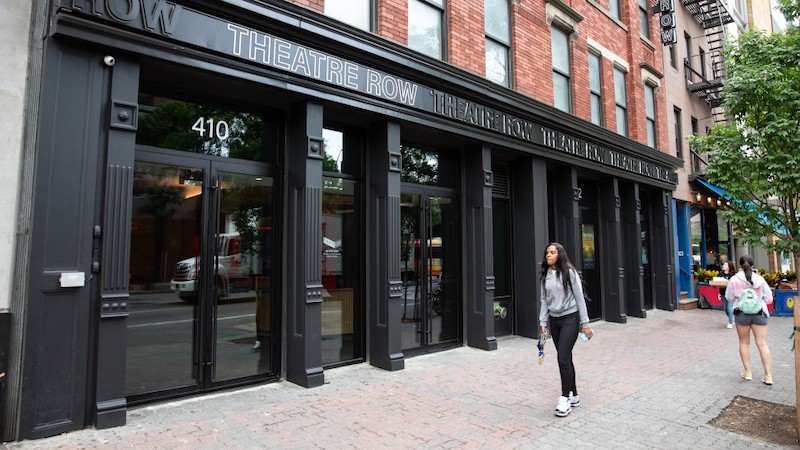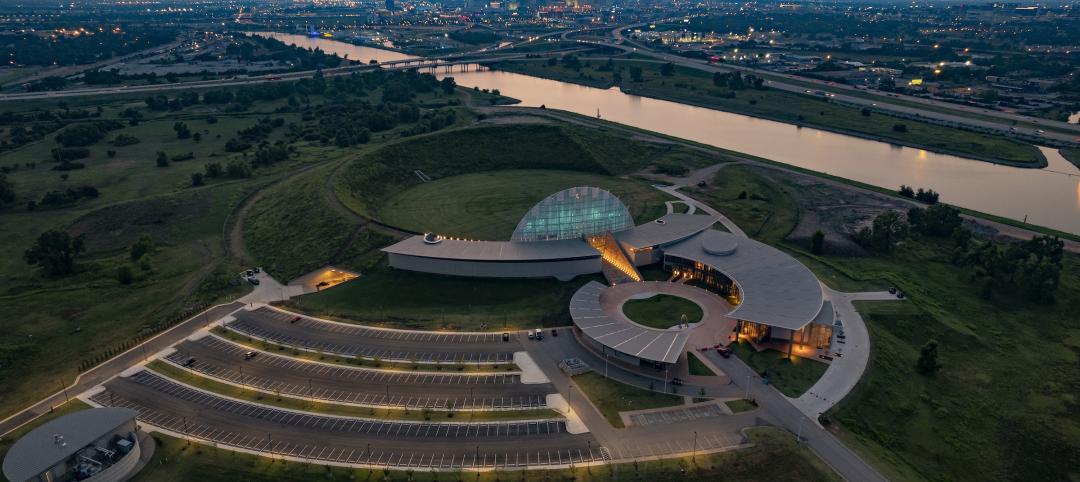There are 748 small theater organizations in New York City that generated $1.3 billion in economic output and supported 8,400 jobs that paid $512 million in annual wages in 2017.
Those statistics come from a 60-page economic impact study that the New York Mayor’s Office of Media and Entertainment (MOME) recently completed with consultative assistance from BuroHappold Cities, the engineering firm’s team that provides strategic planning, project management, and analytical services; and 3x3 Design, which provides social innovation and design strategies for urban and economic development initiatives.
The release of this study coincides with the city’s first-ever public awareness campaign in October that encouraged New York’s residents and visitors to support the city’s small theater scene in all five of its boroughs.
The city commissioned this study at a time when people working in the theater industry continue to face unstable compensation and rents that, over the period analyzed, rose more than double the industry’s wage increases, on a percentage basis. “Housing affordability and rising living costs have particularly outsized implications for this labor force,” the study states.
New York has long been the epicenter for live theater in the United States, and a launching pad for some of the country’s most famous actors. Throughout the city, there are 226 small-venue stages with an aggregate of 51,779 seats. Its 600 production companies include 97 that produce and present theater (with physical locations), and 51 theater organizations that exist under umbrellas of large, non-academic institutions.
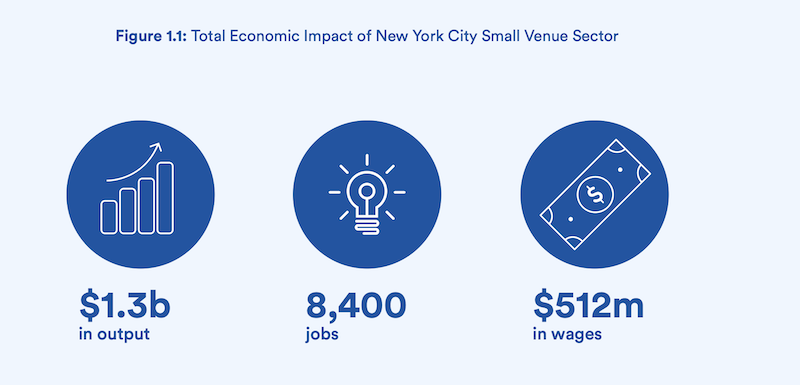
The small-theater sector's economic output increased by 5% annually between 2014 and 2017, a faster clip than the city's overall economic output. Images: New York Office of Media and Entertainment
Over the past decade through 2017, over 280 theater organizations have been founded in New York City, compared with the more than 100 that either closed or relocated.
Between 2014 and 2017, the economic output of the small theater industry increased a 5% annually, a percentage point higher than the total citywide economic output. Consequently, the study calculates, the small venue theater industry’s growth has outpaced baseline economic growth by 20% for economic output, and by 100% for job and wage growth.
The so-called “induced” economic impact—from employees working directly or indirectly for the small theater industry who spent their wages in New York City—found that these workers generated $208 million in output and created nearly 2,000 more jobs in 2017.
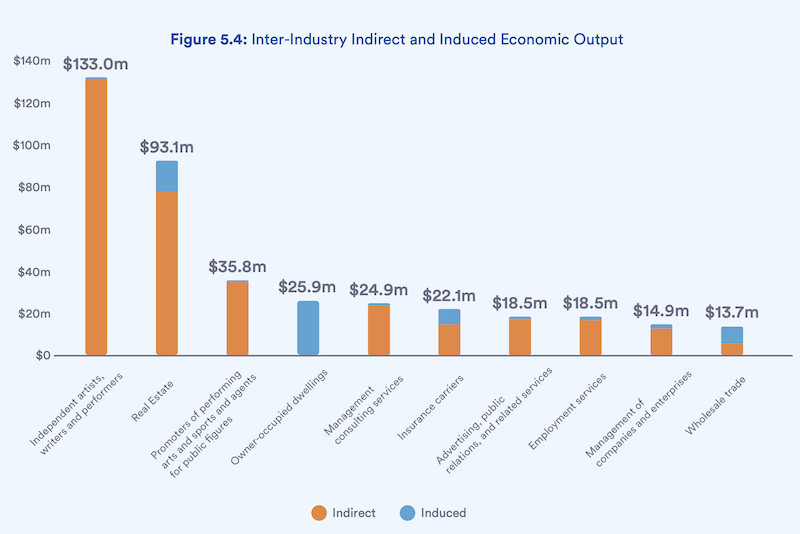
Indirect and induced economic output from people employed in the small theater arena outpaces that from other sectors.
The report includes 267 nonprofits (73 theaters, 182 production companies, and a dozen theaters within larger organizations). The larger organizations (i.e., those with revenue greater than $5 million) account for only 3% of the total number of theatres but generate 74% of the small theater industry’s revenue. Conversely smaller organizations (with under $500,000 in revenue) make up nearly two-thirds of the sector but contribute only 26% of the industry’s revenue.
For large and small nonprofits, programming services—ticketing, space rental, etc.—accounted for 41% of their total annual revenue, on average, with that same percentage coming from private contributions and grants, and 10% from sources such as merchandising and concessions. Government kicks in 8% of the nonprofits’ revenue.
Commercial organizations, on the other hand, may account for only 3% of New York’s small-venue theater organizations, but their 21 theaters generate 11% of the industry’s total revenue. Four commercial theaters alone generated $48.8 million of the $63 million in 2017 revenue that all commercial theaters produced.
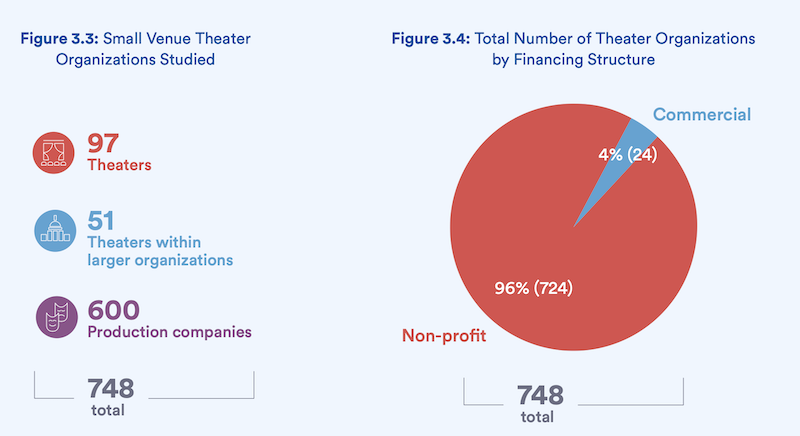
Nonprofits account for the lion's share of small theater organizations.
The future growth within the small theater sector will depend on a number of factors, not the least of which being space availability. The study points out that access to long-term space has given theater organizations the curating flexibility of presenting work that’s produced by outside companies.
Nomadic theater production companies must navigate their space needs on a project-by-project basis. That’s not necessarily a negative, says the study. “[L]ack of site-specific obligations can act as an advantage, allowing [the companies] to be more flexible and adaptive as an organization and to tailor space acquisition to the needs of each specific production.”
In addition, interdisciplinary collaboration and production in spaces beyond traditional theater venues are common in New York’s small theater arena. “This component of the sector has been expanding since the 1980s with the increased development of multimedia and video work,” says the study.
Another factor for sustaining growth of this sector will be the funding support it receives from private and public donors. Newer and less-established theaters typically have more difficulty tapping foundation funding.
Smaller theaters also rely on the city for support. In fiscal 2019, The New York City Department of Cultural Affairs (DCLA) alone provided $45.6 million in expense and operating support for 383 organizations working in theater and/or multidisciplinary arts. (That amount equaled nearly 23% of the department’s expense budget.)
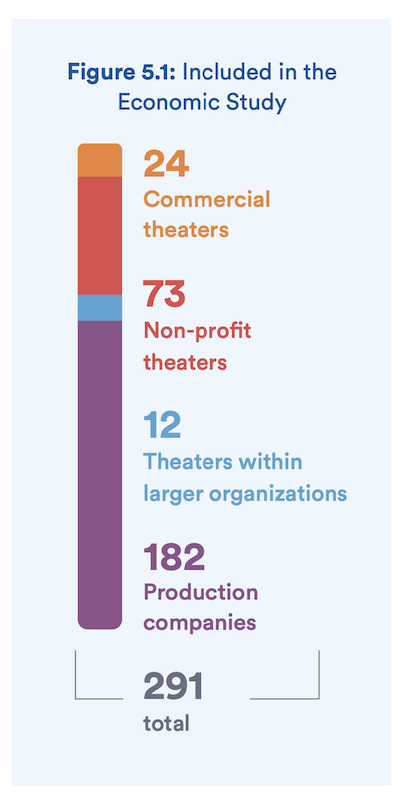
A breakdown of the theater organization types included in the economic impact study.
Since 2000, DCLA has provided funding for 50 theater-related construction projects throughout the city. More than half of the projects received funding in the $10 million range. In addition, the New York State Council on the Arts has contributed to capital improvements of New York City theaters and institutions.
Corporate donors have been relatively few in this sector, and they tend to channel their funding to middle- to larger-tier organizations.
Perhaps the biggest challenge facing small theater organizations is audience retention and expansion. Small theaters are competing for consumer dollars against all kinds of entertainment options (including multimillion dollar shows on Broadway). The diminution of print media makes it harder for small theaters to make their productions known to the public, even given the fact that small-theater productions are more likely to attract local residents than tourists.
To address the audience quandary, theaters are using innovative marketing, including social media and other online platforms to target younger people. The theaters are initiating strategic partnerships with other theaters for co-productions, or even with neighborhoods to promote shows. And they are attempting to cultivate audience segments—such as people of color or those with disabilities—that historically have been under-represented in the theater.
“Theaters are looking to be more rooted in a specific place, deeply embedded in the local framework and engaged with local communities,” the study states.
That study posits that small-venue theater is an integral part of the city’s artistic character, and makes several recommendations about what the city could be doing to help this sector grow.
These include:
•Targeting its support at boroughs outside of Manhattan to help facilitate partnerships with grassroots organizations.
•Supporting promotional and awareness campaigns that spotlight small venue theaters to cultivate audiences.
•Convening sessions to introduce potential partners and mentors who might have new ideas about mining critical resources for these theaters.
•Coordinating different city agencies like DCLA and MOME to support issues surrounding theater owners and operators.
•Building on the theater sector’s existing workforce training partnerships that provide pipelines for employment and union membership, and find ways to support smaller theater companies with their labor needs.
Related Stories
Sustainability | Apr 4, 2023
NIBS report: Decarbonizing the U.S. building sector will require massive, coordinated effort
Decarbonizing the building sector will require a massive, strategic, and coordinated effort by the public and private sectors, according to a report by the National Institute of Building Sciences (NIBS).
Libraries | Mar 26, 2023
An abandoned T.J. Maxx is transformed into a new public library in Cincinnati
What was once an abandoned T.J. Maxx store in a shopping center is now a vibrant, inviting public library. The Cincinnati & Hamilton County Public Library (CHPL) has transformed the ghost store into the new Deer Park Library, designed by GBBN.
Performing Arts Centers | Mar 9, 2023
Two performing arts centers expand New York’s cultural cachet
A performing arts center under construction and the adaptive reuse for another center emphasize flexibility.
Libraries | Feb 26, 2023
A $17 million public library in California replaces one that was damaged in a 2010 earthquake
California’s El Centro community, about two hours east of San Diego, recently opened a new $17 million public library. With design by Ferguson Pape Baldwin Architects and engineering services by Latitude 33 Planning & Engineering, the 19,811-sf building replaces the previous library, which was built in the early 1900s, damaged by a 7.2 earthquake that struck Baja California in 2010, and demolished in 2016.
Museums | Feb 22, 2023
David Chipperfield's 'subterranean' design wins competition for National Archaeological Museum in Athens
Berlin-based David Chipperfield Architects was selected as the winner of the design competition for the new National Archaeological Museum in Athens. The project will modernize and expand the original neoclassical museum designed by Ludwig Lange and Ernst Ziller (1866-1874) with new spaces that follow the existing topography of the site. It will add approximately 20,000 sm of space to the existing museum, as well as a rooftop park that will be open to the public.
Museums | Feb 17, 2023
First Americans Museum uses design metaphors of natural elements to honor native worldview
First Americans Museum (FAM) in Oklahoma City honors the 39 tribes in Oklahoma today, reflecting their history through design metaphors of nature’s elements of earth, wind, water, and fire. The design concept includes multiple circles suggested by arcs, reflecting the native tradition of a circular worldview that encompasses the cycle of life, the seasons, and the rotation of the earth.
Giants 400 | Feb 9, 2023
New Giants 400 download: Get the complete at-a-glance 2022 Giants 400 rankings in Excel
See how your architecture, engineering, or construction firm stacks up against the nation's AEC Giants. For more than 45 years, the editors of Building Design+Construction have surveyed the largest AEC firms in the U.S./Canada to create the annual Giants 400 report. This year, a record 519 firms participated in the Giants 400 report. The final report includes 137 rankings across 25 building sectors and specialty categories.
Giants 400 | Feb 6, 2023
2022 Reconstruction Sector Giants: Top architecture, engineering, and construction firms in the U.S. building reconstruction and renovation sector
Gensler, Stantec, IPS, Alfa Tech, STO Building Group, and Turner Construction top BD+C's rankings of the nation's largest reconstruction sector architecture, engineering, and construction firms, as reported in the 2022 Giants 400 Report.
Giants 400 | Feb 6, 2023
2022 Religious Sector Giants: Top architecture, engineering, and construction firms in the U.S. religious facility construction sector
HOK, Parkhill, KPFF, Shawmut Design and Construction, and Wiss, Janney, Elstner head BD+C's rankings of the nation's largest religious facility sector architecture, engineering, and construction firms, as reported in the 2022 Giants 400 Report.
Steel Buildings | Feb 3, 2023
Top 10 structural steel building projects for 2023
A Mies van der Rohe-designed art and architecture school at Indiana University and Morphosis Architects' Orange County Museum of Art in Costa Mesa, Calif., are among 10 projects to win IDEAS² Awards from the American Institute of Steel Construction.


